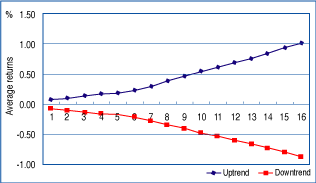Paper Umbrellas
The Dynamics Of Candlestick Patterns
by Shijoong Sung, PhD
Candlestick patterns have been used for centuries, but given that they have received so much attention among technical analysts, can they still be used in the conventional way?
If a hammer pattern appears during a bearish trend, does that mean you should plunge into the market? If a hanging man pattern appears during a bullish trend, does that mean you should exit the market immediately? Little is known about the effects and dynamics of candlestick patterns, so to find out more, I did a thorough and systematic investigation of 351,745 candlestick patterns. My analysis seemed to suggest that the conventional way of interpreting candlestick patterns should be reconsidered.
MYSTERY
Typically, a hammer that occurs in a downtrend suggests a trend reversal. Similarly, a hanging man pattern in an uptrend suggests the trend will end and the market will reverse. It is a nice surprise to see a hammer pattern that turns a bearish price movement into a bullish one, or a hanging man pattern that turns a bullish movement into a bearish one. But that doesn't mean you can make money from these patterns. From my analysis, I found that there are many hammer patterns that give the correct bullish signal. Unfortunately, there can be just as many -- or even more -- hammer patterns that give the false signal. Is it really favorable to take any action when these patterns appear?
Another important issue that is rarely addressed is the amount of time it takes for the expected price movement to continue after a specific candlestick pattern occurs. When should you take action? Candlestick patterns are usually considered to have a very short-term effect. But is that really the case?
To answer these riddles, it is necessary to perform a systematic investigation into how the market reacts to these patterns. To analyze the pattern effectiveness and the time it takes for price movement of the patterns, I collected about eight years of daily data from the KOSPI 200 stock index, which is listed on the Korea Stock Exchange. There were approximately 1,758 candlesticks for each symbol studied. In total, I investigated 351,745 candlestick patterns.

FIGURE 1: UPTRENDS, DOWNTRENDS, AND CANDLESTICKS. Here you see the average returns depending upon the trend definition. Note that the upward bias of the data has been corrected.
...Continued in the December issue of Technical Analysis
of STOCKS & COMMODITIES
Excerpted from an article originally published in the December 2004 issue of Technical Analysis of STOCKS & COMMODITIES magazine. All rights reserved. © Copyright 2004, Technical Analysis, Inc.
Return to December 2004 Contents